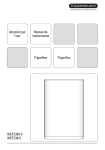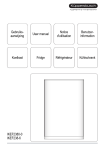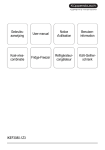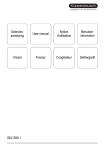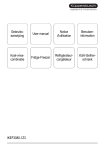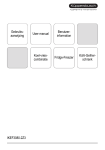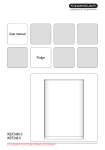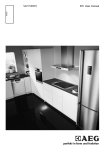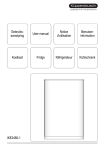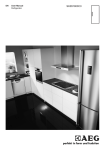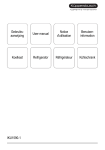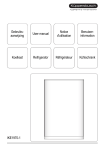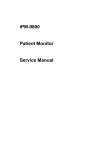Download Gebruiks- aanwijzing Koelkast User manual Fridge Notice d
Transcript
Gebruiksaanwijzing User manual Notice d'utilisation Benutzerinformation Koelkast Fridge Réfrigérateur Kühlschrank IKEF2380-0 IKEF238-6 15 Contents Safety information Control panel First use Daily use Helpful hints and tips 15 17 18 18 22 Care and cleaning What to do if… Technical data Installation Environmental concerns 23 24 26 26 26 Subject to change without notice Safety information In the interest of your safety and to ensure the correct use, before installing and first using the appliance, read this user manual carefully, including its hints and warnings. To avoid unnecessary mistakes and accidents, it is important to ensure that all people using the appliance are thoroughly familiar with its operation and safety features. Save these instructions and make sure that they remain with the appliance if it is moved or sold, so that everyone using it through its life will be properly informed on appliance use and safety. For the safety of life and property keep the precautions of these user's instructions as the manufacturer is not responsible for damages caused by omission. Children and vulnerable people safety • This appliance is not intended for use by persons (including children) with reduced physical, sensory or mental capabilities, or lack of experience and knowledge, unless they have been given supervision or instruction concerning use of the appliance by a person responsible for their safety. Children should be supervised to ensure that they do not play with the appliance. • Keep all packaging well away from children. There is risk of suffocation. • If you are discarding the appliance pull the plug out of the socket, cut the connection cable (as close to the appliance as you can) and remove the door to prevent playing children to suffer electric shock or to close themselves into it. • If this appliance featuring magnetic door seals is to replace an older appliance having a spring lock (latch) on the door or lid, be sure to make that spring lock unusable before you discard the old appliance. This will prevent it from becoming a death trap for a child. General safety Caution! Keep ventilation openings clear of obstruction. • The appliance is intended for keeping foodstuff and/or beverages in a normal household as explained in this instruction booklet. • Do not use a mechanical device or any artificial means to speed up the thawing process. • Do not use other electrical appliances (such as ice cream makers) inside of refrigerating appliances, unless they are approved for this purpose by the manufacturer. • Do not damage the refrigerant circuit. • The refrigerant isobutane (R600a) is contained within the refrigerant circuit of the appliance, a natural gas with a high level of environmental compatibility, which is nevertheless flammable. During transportation and installation of the appliance, be certain that none of the components of the refrigerant circuit become damaged. If the refrigerant circuit should become damaged: – avoid open flames and sources of ignition – thoroughly ventilate the room in which the appliance is situated 16 • It is dangerous to alter the specifications or modify this product in any way. Any damage to the cord may cause a short-circuit, fire and/or electric shock. cause it to explode, resulting in damage to the appliance. • Ice lollies can cause frost burns if consumed straight from the appliance. Warning! Any electrical component (power cord, plug, compressor) must be replaced by a certified service agent or qualified service personnel. Care and cleaning • Before maintenance, switch off the appliance and disconnect the mains plug from the mains socket. • Do not clean the appliance with metal objects. • Do not use sharp objects to remove frost from the appliance. Use a plastic scraper. • Regularly examine the drain in the refrigerator for defrosted water. If necessary, clean the drain. If the drain is blocked, water will collect in the bottom of the appliance. 1. Power cord must not be lengthened. 2. Make sure that the power plug is not squashed or damaged by the back of the appliance. A squashed or damaged power plug may overheat and cause a fire. 3. Make sure that you can come to the mains plug of the appliance. 4. Do not pull the mains cable. 5. If the power plug socket is loose, do not insert the power plug. There is a risk of electric shock or fire. 6. You must not operate the appliance without the lamp cover5) of interior lighting. • This appliance is heavy. Care should be taken when moving it. • Do not remove nor touch items from the freezer compartment if your hands are damp/wet, as this could cause skin abrasions or frost/freezer burns. • Avoid prolonged exposure of the appliance to direct sunlight. Daily Use • Do not put hot pot on the plastic parts in the appliance. • Do not store flammable gas and liquid in the appliance, because they may explode. • Do not place food products directly against the air outlet on the rear wall.6) • Frozen food must not be re-frozen once it has been thawed out. • Store pre-packed frozen food in accordance with the frozen food manufacturer's instructions. • Appliance's manufacturers storage recommendations should be strictly adhered to. Refer to relevant instructions. • Do not place carbonated or fizzy drinks in the freezer compartment as it creates pressure on the container, which may 5) If the lamp cover is foreseen 6) If the appliance is Frost Free 7) If a water connection is foreseen Installation Important! For electrical connection carefully follow the instructions given in specific paragraphs. • Unpack the appliance and check if there are damages on it. Do not connect the appliance if it is damaged. Report possible damages immediately to the place you bought it. In that case retain packing. • It is advisable to wait at least four hours before connecting the appliance to allow the oil to flow back in the compressor. • Adequate air circulation should be around the appliance, lacking this leads to overheating. To achieve sufficient ventilation follow the instructions relevant to installation. • Wherever possible the back of the product should be against a wall to avoid touching or catching warm parts (compressor, condenser) to prevent possible burn. • The appliance must not be located close to radiators or cookers. • Make sure that the mains plug is accessible after the installation of the appliance. • Connect to potable water supply only.7) Service • Any electrical work required to do the servicing of the appliance should be carried out by a qualified electrician or competent person. 17 and rubbish. The insulation foam contains flammable gases: the appliance shall be disposed according to the applicable regulations to obtain from your local authorities. Avoid damaging the cooling unit, especially at the rear near the heat exchanger. The materials used on this appliance marked by the symbol are recyclable. • This product must be serviced by an authorized Service Centre, and only genuine spare parts must be used. Environment Protection This appliance does not contain gasses which could damage the ozone layer, in either its refrigerant circuit or insulation materials. The appliance shall not be discarded together with the urban refuse Control panel 1 1 2 3 4 5 6 7 8 9 2 3 4 Fridge Pilot light Fridge ON/OFF switch Fridge temperature regulator, + button Fridge temperature indicator Fridge temperature regulator, - button Superfrost indicator Superfrost button Supercool indicator Supercool button Switching on the fridge 1. Insert the plug into the mains socket. 2. Press ON/OFF switch . 3. The Pilot Light will light up. Switching off the fridge 1. Keep ON/OFF switch pressed for more than 5 seconds. 2. After that, a countdown of the temperature from -3 -2 -1 will be shown. When “1” appears the fridge is turned off. The temperature indicator switches off. The Pilot light switches off. Temperature setting buttons The temperature is adjusted using the temperature setting buttons. These buttons are connected to the temperature indicator. • The temperature indicator is switched over from the indicator of the ACTUAL temperature (Temperature indicator is illuminated) to the indicator of the DESIRED tempera- 5 6 7 8 9 ture (Temperature indicator flashes) by pressing one of the Temperature setting buttons. • Each time one of the two buttons is pressed again the DESIRED temperature is adjusted by 1°C. The DESIRED temperature must be reached within 24 hours. If neither button is pressed, the temperature indicator automatically switches back after a short period (approx. 5 sec.) to the indicator of the ACTUAL temperature. DESIRED temperature means: The temperature that has been selected for inside the fridge. The DESIRED temperature is indicated by flashing numbers. ACTUAL temperature means: The temperature indicator shows the current temperature inside the fridge. The ACTUAL temperature is indicated with illuminated numbers. Temperature indicator The temperature indicator shows several information: • During normal operation, the temperature currently present in the fridge (ACTUAL temperature) is displayed. • When the temperature is being adjusted a flashing display indicates the fridge temperature currently set (DESIRED temperature). 18 When changing the temperature setting wait about 24 hours until the temperature display has stabilised. Temperature regulation To operate the appliance, proceed as follows: 1. Set the required temperature by pressing the corresponding temperature regulator. The temperature indicator will immediately show the changed setting (DESIRED temperature) and the temperature indicator flashes. 2. Each time the temperature regulator is pressed the DESIRED temperature is adjusted by 1 °C. The DESIRED temperature must be reached within 24 hours. 3. Once the required temperature has been set, after a short period (approx. 5 sec.) the temperature indicator will show again the current ACTUAL temperature inside the corresponding compartment. The temperature indicator will change from flashing to continuous illumination. For a correct storage of the food the following temperature should be set: • +5 °C in the fridge Important! When the setting is changed, the compressor does not start immediately if automatic defrosting is currently taking place. As the storage temperature within the fridge is reached quickly you can store food immediately after switching on. Supercool function The Supercool function is suited for quick cooling of large quantities of goods in the refrigerator. To activate the function, do these steps: 1. Press the Supercool button. 2. The Supercool indicator switches on. The Supercool function now provides for intensive cooling. A DESIRED temperature of +3°C is automatically selected. The Supercool function is ended automatically after a period of 6 hours. You can deactivate the function at any time: 1. Press the Supercool button. 2. The Supercool indicator switches off. Superfrost function You can activate the Superfrost function by pressing the Superfrost button. The Superfrost light will light up. This function stops automatically after 52 hours. It is possible to deactivate the function at any time by pressing the Superfrost button. The Superfrost light will switch off. First use Cleaning the interior Before using the appliance for the first time, wash the interior and all internal accessories with lukewarm water and some neutral soap so as to remove the typical smell of a brandnew product, then dry thoroughly. Daily use Movable shelves The walls of the refrigerator are equipped with a series of runners so that the shelves can be positioned as desired. For better use of space, the front half-shelves can lie over the rear ones. Important! Do not use detergents or abrasive powders, as these will damage the finish. 19 The maximum amount of food that can be frozen in 24 hours is specified on the rating plate , a label located on the inside of the appliance. The freezing process lasts 24 hours: during this period do not add other food to be frozen. When the freezing process is completed, return to the required temperature (see "Superfrost Function"). Positioning the door shelves To permit storage of food packages of various sizes, the door shelves can be placed at different heights. To make these adjustments proceed as follows: gradually pull the shelf in the direction of the arrows until it comes free, then reposition as required. Thawing Deep-frozen or frozen food, prior to being used, can be thawed in the refrigerator compartment or at room temperature, depending on the time available for this operation. Small pieces may even be cooked still frozen, directly from the freezer: in this case, cooking will take longer. Storage of frozen food When first starting-up or after a period out of use, before putting the products in the compartment let the appliance run at least 2 hours on the higher settings. Important! In the event of accidental defrosting, for example due to a power failure, if the power has been off for longer than the value shown in the technical characteristics chart under "rising time", the defrosted food must be consumed quickly or cooked immediately and then re-frozen (after cooling). Freezing Calendar Freezing fresh food The freezer compartment is suitable for freezing fresh food and storing frozen and deep-frozen food for a long time. To freeze fresh food activate the Superfrost function at least 24 hours before placing the food to be frozen in the freezer compartment. The symbols show different types of frozen goods. The numbers indicate storage times in months for the appropriate types of frozen goods. Whether the upper or lower value of the indicated storage time is valid depends on the quality of the foods and treating before freezing. Ice-cube production This appliance is equipped with one or more trays for the production of ice-cubes. Fill these trays with water, then put them in the freezer compartment. 20 Important! Do not use metallic instruments to remove the trays from the freezer. 0°C Compartment In the 0°C compartment the temperature is controlled automatically. It stays constantly at about 0°C, no adjustment is necessary. The constant storage temperature of about 0°C and the relative humidity of between 45 and 90 % provide optimal conditions for the various kinds of food. Important! You can therefore store a variety of fresh food in the 0°C compartment, where it will last up to 3 times longer with better quality compared to normal refrigerator compartments. This allows you to stock more fresh food. Taste, degree of freshness, quality and nutritional values (vitamins and minerals) are well preserved. Loss of weight in vegetables and fruit diminishes. Food yields a higher degree of nutritional value. Humidity control Both drawers can be used according to the desired storage conditions independently of each other with lower or higher humidity. Regulation for each drawer is separate and is controlled using the slide valve at the front of the drawer. • „Dry“: low air humidity - up to 50 % relative humidity This humidity level is reached when both sliders are set into this position and the ventilation openings are wide open. • Humid“: high relative humidity - up to 90% This humidity level is reached when both sliders are set in this position and the ventilation openings are closed. Humidity is kept and can not escape. Important! The 0°C compartment is also suitable for defrosting food. In this case the thawed food can be stored up to two days . Storage time in the 0°C compartment for fresh food Type of food Air humidity adjustment Storage time Onion "dry” up to 5 months Butter “dry” up to 1 month Large pork cuts “dry” up to 10 days Beef, venison, small pork cuts, poultry “dry” up to 7 days Tomato sauce “dry” up to 4 days Fish, shellfish, cooked meat products “dry” up to 3 days Cooked seafood “dry” up to 2 days Salad, vegetables Carrots, herbs, Brussels sprouts, celery “humid” up to 1 month Artichokes, cauliflower, chicory, iceberg lettuce, endive, lamb’s lettuce, lettuce, leeks, radicchio “humid” up to 21 days Broccoli, Chinese leaves, kale, cabbage, radishes, Savoy cabbage “humid” up to 14 days 21 Type of food Air humidity adjustment Storage time Peas, kohlrabi “humid” up to 10 days Spring onions, radishes, asparagus, spinach “humid” up to 7 days Fruit 1) Pears, dates (fresh), strawberries, peaches 1) “humid” up to 1 month Plums 1) rhubarb, gooseberries “humid” up to 21 days Apples (not sensitive to cold), quinces “humid” up to 20 days Apricots, cherries “humid” up to 14 days Damsons, grapes “humid” up to 10 days Blackberries, currants “humid” up to 8 days Figs (fresh) “humid” up to 7 days Blueberries, raspberries “humid” up to 5 days 1) The riper the fruit, the shorter the storage time Important! Cakes containing cream and other kinds of pastry products can be stored in the 0°C compartment for 2 or 3 days. Important! Not to be placed in the 0°C compartment: • cold sensitive fruit which have to be stored at cellar or room temperature like pineapple, bananas, grapefruit, melons, mango, papaya, oranges, lemons, kiwi fruit. • The types of food not mentioned above should be stored in the refrigerator compartment (e.g. all sorts of cheese, cold cuts, etc.) Important! The level of air humidity in the drawers depends on the content of humidity in the stored food, vegetable and fruit and on the frequency of door opening The 0°C compartment is also suitable for slow thawing of food. In this case the thawed food can be stored in the 0°C compartment for up to two days. Tips: • Pay attention to the freshness of the food, especially on the expiry date. Quality and freshness influence the storage time. • The whole storage cycle time will depend on the preservation conditions made prior to the final storage in the fridge. • Food, fruit or vegetables should always be packed or wrapped up before storage. • Animal food always store packed and dry. • Food rich in proteins will go bad quicker. This means seafood will spoil before fish which in turn will spoil before meat. While storing food in a 0°C compartment storage time for that kind of food can be increased by up to three times as well without loss on quality. • All food stored in a 0°C compartment should be taken out of the drawers roughly 15-30 min before consumption, particularly fruit and vegetables to be consumed without any additional cooking process. Allowing fruit and vegetables to return to room temperature will improve the texture and flavour. Drawer The wire shelves inside the drawers permit that air can circulate freely and consequently a better conservation of foods. The compartment has stops to prevent the drawers from falling out when fully extended. To remove the drawers (e.g. for cleaning purposes), pull them out as far as the stops, lift and extract.. . 22 Helpful hints and tips Hints for energy saving • Do not open the door frequently or leave it open longer than absolutely necessary. • If the ambient temperature is high and the Temperature Regulator is set to low temperature and the appliance is fully loaded, the compressor may run continuously, causing frost or ice on the evaporator. If this happens, set the Temperature Regulator toward warmer settings to allow automatic defrosting and so a saving in electricity consumption. Fruit and vegetables: these should be thoroughly cleaned and placed in the special drawer(s) provided. Butter and cheese: these should be placed in special airtight containers or wrapped in aluminium foil or polythene bags to exclude as much air as possible. Milk bottles: these should have a cap and should be stored in the bottle rack on the door. Bananas, potatoes, onions and garlic, if not packed, must not be kept in the refrigerator. Hints for fresh food refrigeration To obtain the best performance: • do not store warm food or evaporating liquids in the refrigerator • do cover or wrap the food, particularly if it has a strong flavour • position food so that air can circulate freely around it Hints for freezing To help you make the most of the freezing process, here are some important hints: • the maximum quantity of food which can be frozen in 24 hrs. is shown on the rating plate; • the freezing process takes 24 hours. No further food to be frozen should be added during this period; • only freeze top quality, fresh and thoroughly cleaned, foodstuffs; • prepare food in small portions to enable it to be rapidly and completely frozen and to make it possible subsequently to thaw only the quantity required; • wrap up the food in aluminium foil or polythene and make sure that the packages are airtight; Hints for refrigeration Useful hints: Meat (all types) : wrap in polythene bags and place on the glass shelf above the vegetable drawer. For safety, store in this way only one or two days at the most. Cooked foods, cold dishes, etc..: these should be covered and may be placed on any shelf. 23 • do not allow fresh, unfrozen food to touch food which is already frozen, thus avoiding a rise in temperature of the latter; • lean foods store better and longer than fatty ones; salt reduces the storage life of food; • water ices, if consumed immediately after removal from the freezer compartment, can possibly cause the skin to be freeze burnt; • it is advisable to show the freezing in date on each individual pack to enable you to keep tab of the storage time. • make sure that the commercially frozen foodstuffs were adequately stored by the retailer; • be sure that frozen foodstuffs are transferred from the foodstore to the freezer in the shortest possible time; • not open the door frequently or leave it open longer than absolutely necessary. • Once defrosted, food deteriorates rapidly and cannot be refrozen. • Do not exceed the storage period indicated by the food manufacturer. Hints for storage of frozen food To obtain the best performance from this appliance, you should: Care and cleaning Caution! Unplug the appliance before carrying out any maintenance operation. This appliance contains hydrocarbons in its cooling unit; maintenance and recharging must therefore only be carried out by authorized technicians. Periodic cleaning The equipment has to be cleaned regularly: • clean the inside and accessories with lukewarm water and some neutral soap. • regularly check the door seals and wipe clean to ensure they are clean and free from debris. • rinse and dry thoroughly. Important! Do not pull, move or damage any pipes and/or cables inside the cabinet. Never use detergents, abrasive powders, highly perfumed cleaning products or wax polishes to clean the interior as this will damage the surface and leave a strong odour. Clean the condenser (black grill) and the compressor at the back of the appliance with a brush or a vacuum cleaner. This operation will improve the performance of the appliance and save electricity consumption. The lowest shelf, dividing the cooler compartment from the 0°C compartment can be removed only for cleaning. To remove pull out the shelf straight. The cover plates above the drawers in the compartment can be taken out for cleaning. Important! To make sure fully functionality of the 0°C compartment the lowest shelf and cover plates must be put back in their original position after cleaning. Important! Take care of not to damage the cooling system. Many proprietary kitchen surface cleaners contain chemicals that can attack/damage the plastics used in this appliance. For this reason it is recommended that the outer casing of this appliance is only cleaned with warm water with a little washing-up liquid added. After cleaning, reconnect the equipment to the mains supply. Defrosting of the refrigerator Defrosting of the fridge compartment is automatic. The water that forms flows into a recipient on the compressor and evaporates. This recipient cannot be removed. Defrosting the freezer A certain amount of frost will always form around the top compartment. Important! Defrost the freezer when the frost layer reaches a thickness of about 3-5 mm. To remove the frost, do these steps: 24 1. Switch off the appliance. 2. Remove any stored food, wrap it in several layers of newspaper and put it in a cool place. 3. Open the door. 4. When defrosting is completed, dry the interior thoroughly. 5. Switch on the appliance. 6. Set the temperature regulator to obtain the maximum coldness and run the appliance for two or three hours using this setting. 7. Reload the previously removed food into the compartment. Warning! Never use sharp metal tools to scrape off frost from the evaporator as you could damage it. Do not use a mechanical device or any artificial means to speed up the thawing process other than those recommended by the manufacturer. A temperature rise of the frozen food packs, during defrosting, may shorten their safe storage life. Periods of non-operation When the appliance is not in use for long periods, take the following precautions: • disconnect the appliance from electricity supply • remove all food • defrost 8)and clean the appliance and all accessories • leave the door/doors ajar to prevent unpleasant smells. If the cabinet will be kept on, ask somebody to check it once in a while to prevent the food inside from spoiling in case of a power failure. What to do if… Warning! Before troubleshooting, disconnect the mains plug from the mains socket. Only a qualified electrician or competent person must do the troubleshooting that is not in this manual. Problem Important! There are some sounds during normal use (compressor, refrigerant circulation). Possible cause Solution The appliance is noisy The appliance is not supported properly Check if the appliance stands stable (all the four feet should be on the floor) The appliance does not operate. The lamp does not operate. The appliance is switched off. Switch on the appliance. The mains plug is not connected to the mains socket correctly. Connect the mains plug to the mains socket correctly. The appliance has no power. There is no voltage in the mains socket. Connect a different electrical appliance to the mains socket. Contact a qualified electrician. The lamp is in stand-by. Close and open the door. The lamp is defective. Refer to "Replacing the lamp". The temperature is not set correctly. Set a higher temperature. The door is not closed correctly. Refer to "Closing the door". The door has been opened too frequently. Do not keep the door open longer than necessary. The product temperature is too high. Let the product temperature decrease to room temperature before storage. The lamp does not work. The compressor operates continually. 8) If foreseen. 25 Problem Possible cause The room temperature is too high. The compressor does not This is normal, no error has occurred. start immediately after pressing the Superfrost or Supercool switch, or after changing the temperature. Solution Decrease the room temperature. The compressor starts after a period of time. Temperature cannot be set . Superfrost or Supercool functions switched on. Switch off Superfrost or Supercool manually, or wait to set the temperature until the function has reset automatically. Refer to "Superfrost or Supercool function". The temperature in the appliance is too low/high. The temperature regulator is not set correctly. Set a higher/lower temperature. The door is not closed correctly. Refer to "Closing the door". The product temperature is too high. Let the product temperature decrease to room temperature before storage. Many products are stored at the same time. Store less products at the same time. The temperature in the refrigerator is too high. There is no cold air circulation in the appliance. Make sure that there is cold air circulation in the appliance. The temperature in the freezer is too high. Products are too near to each other. Store products so that there is cold air circulation. There is too much frost. Food is not wrapped correctly. Wrap the food correctly. The door is not closed correctly. Refer to "Closing the door". The temperature regulator is not set correctly. Set a higher temperature. Replacing the lamp 1. Disconnect the mains plug from the mains socket. 2. Press on the rear hook and at the same time slide the lamp cover in the direction of the arrow. 3. Replace the lamp with one of the same power (the maximum power is shown on the light lamp cover) 4. Install the lamp cover by sliding it into its original position. 5. Connect the mains plug to the mains socket. 6. Open the door. Make sure that the lamp comes on. Closing the door 1. Clean the door gaskets. 2. If necessary, adjust the door. Refer to "Installation". 26 3. If necessary, replace the defective door gaskets. Contact the Service Center. Technical data Dimension of the recess Height 1225 mm Width 560 mm Depth 550 mm Rising Time 12 h The technical information are situated in the rating plate on the internal left side of the appliance and in the energy label. Installation Read the "Safety Information" carefully for your safety and correct operation of the appliance before installing the appliance. Positioning Install this appliance at a location where the ambient temperature corresponds to the climate class indicated on the rating plate of the appliance: Climate class Ambient temperature SN +10°C to + 32°C N +16°C to + 32°C ST +16°C to + 38°C T +16°C to + 43°C Electrical connection Before plugging in, ensure that the voltage and frequency shown on the rating plate correspond to your domestic power supply. The appliance must be earthed. The power supply cable plug is provided with a contact for this purpose. If the domestic power supply socket is not earthed, connect the appliance to a separate earth in compliance with current regulations, consulting a qualified electrician. The manufacturer declines all responsibility if the above safety precautions are not observed. This appliance complies with the E.E.C. Directives. Ventilation requirements The airflow behind the appliance must be sufficient. min. 200 cm2 min. 200 cm2 Environmental concerns The symbol on the product or on its packaging indicates that this product may not be treated as household waste. Instead it should be taken to the appropriate collection point for the recycling of electrical and electronic equipment. By ensuring this product is disposed of correctly, you will help prevent potential negative consequences for the environment and human health, which could otherwise be caused by inappropriate waste handling of this product. For more 27 detailed information about recycling of this product, please contact your local council, your household waste disposal service or the shop where you purchased the product.














